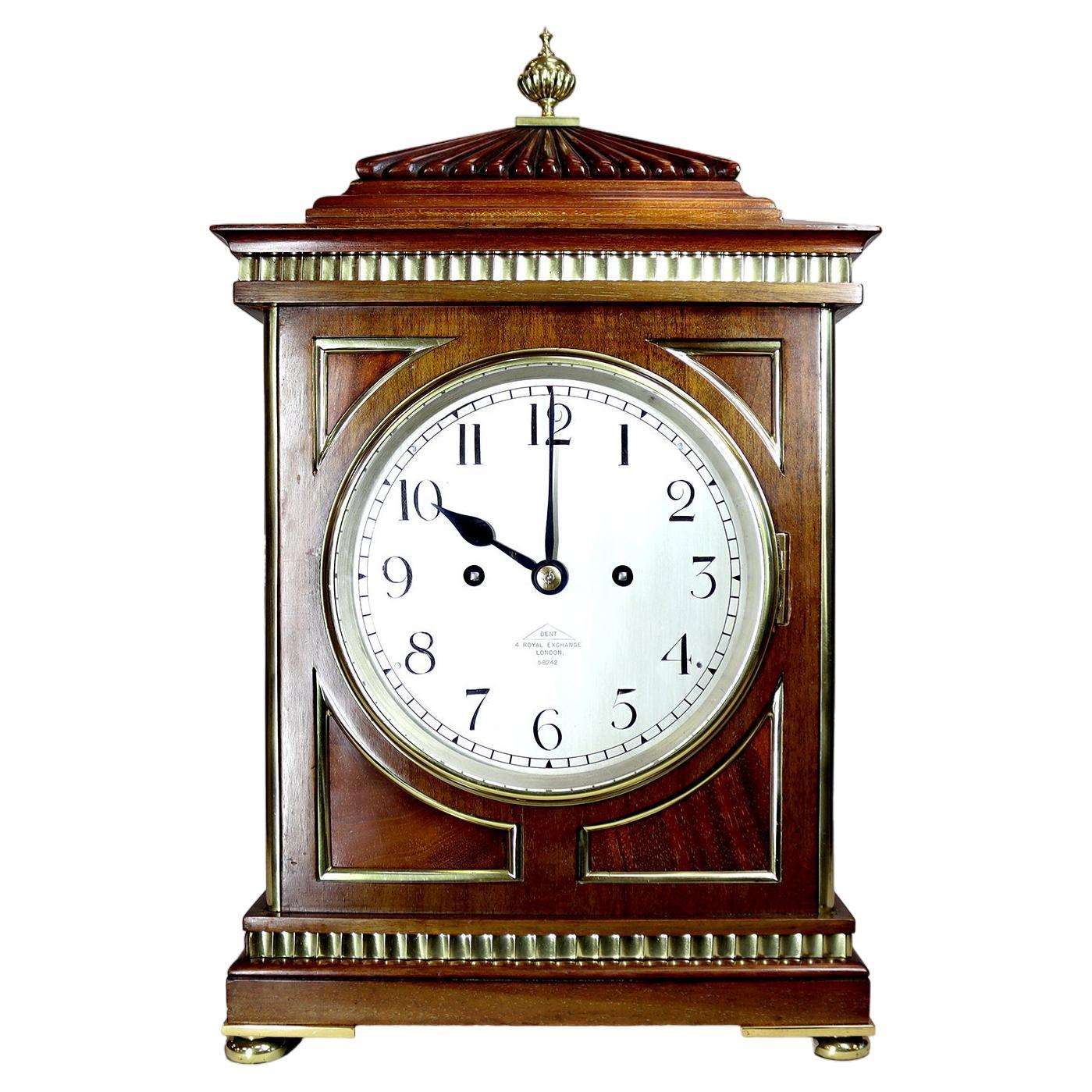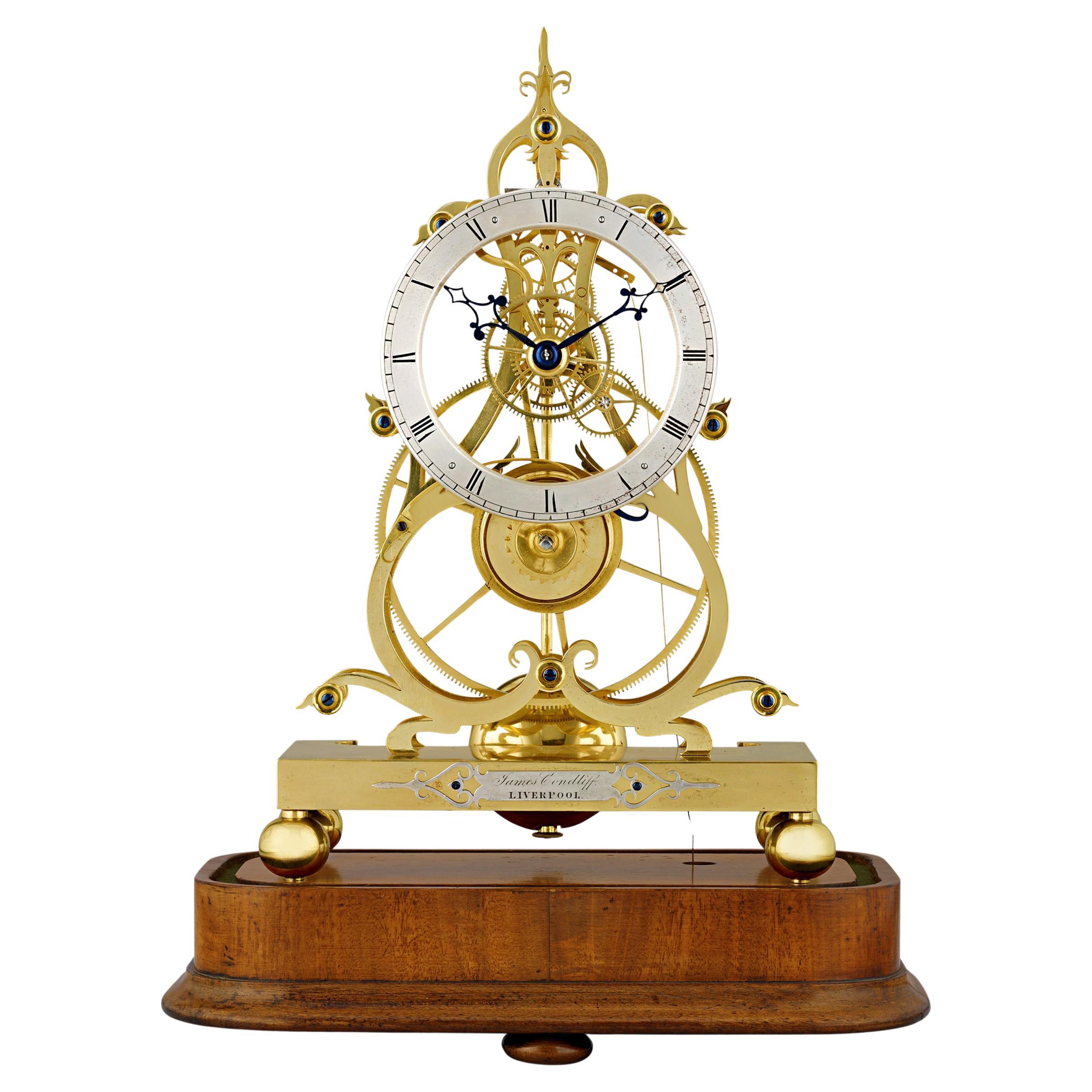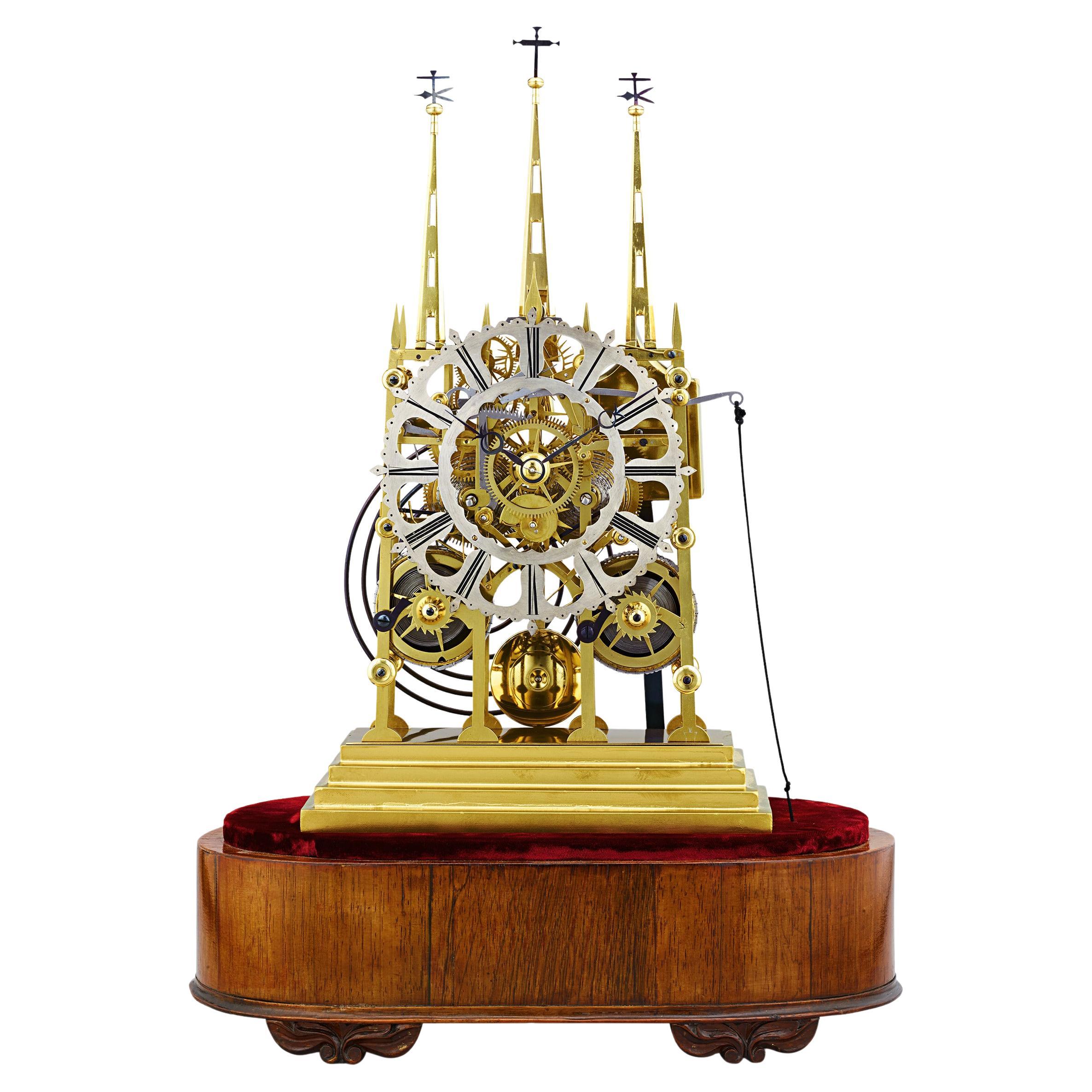Items Similar to c. 1973 Replica of a Strutt Epicyclic Skeleton Clock by Dent
Want more images or videos?
Request additional images or videos from the seller
1 of 7
c. 1973 Replica of a Strutt Epicyclic Skeleton Clock by Dent
About the Item
Maker:
Dent
Originally designed by W. Wigston and W. Strutt c.1820.
Dial:
The skeletonized dial has white Arabic numbers for the hours, black dots for the minutes and steel cut hands.
Movement:
The single fusee movement has heavy chamfered plates with large screwed posts at the ends of the c-scrolls, an anchor escapement, a pendulum with lenticular bob suspended from a steel suspension and adjusted by a rating screw and finely spoked wheelwork with the epicyclic planetary gear at the front.
Notes:
Dent produced a limited edition of 100 Strutt clocks.
The top of the backplate has ‘Made in England’ and two stylized signatures for Wigston and Whitmire.
It still retains the original brass bound glass cover.
Ref:
For a complete discussion on epicyclic gearing, Strutt and several different copies including Dent’s see: ‘British Skeleton Clocks’, Roberts, pgs. 160-169.
Unless otherwise noted all our clocks are properly serviced, sold in working condition, fitted with the proper size keys, and guaranteed mechanically for 1 year.
About the Seller
5.0
Vetted Seller
These experienced sellers undergo a comprehensive evaluation by our team of in-house experts.
Established in 1971
1stDibs seller since 2021
Typical response time: <1 hour
- ShippingRetrieving quote...Ships From: Greenlawn, NY
- Return PolicyA return for this item may be initiated within 3 days of delivery.
More From This SellerView All
- c.1876 French Quarter-Striking Carriage Clock by BreguetBy Breguet a ParisLocated in Greenlawn, NYMaker: Breguet # 5257 Stamped Soldano on the underside of the platform. Case: The gilt-bronze case with original gold in typical gorge-cased form is stamped on the underside ‘440’ and ‘1275’. Dial: The white porcelain dial has Roman numerals for the hours, steel-cut Breguet-style hands and is signed ‘Breguet, 5257’. Movement: The eight-day movement has all the indications in both French and English, has a blank stamp where the the trade-mark stamp for the ebauche maker was scrubbed, is numbered ‘1275’ and ‘440’, is engraved ‘Breguet, 5257’ and strikes the quarters on a bell. Above sits the balance platform with a lever escapement and a beautifully engine-turned mask. The underside is stamped Soldano. Notes: Breguet was founded by Abraham Louis Breguet and is one of the most famous horological dynasties in history. The are noted for exceptional quality and design and often for advanced technological innovations and their pieces always demand a premium. They are one of the few firms that still have extensive sales records and know who the original buyers were for each and every piece. An Official Breguet Attestation from 2010 states that this clock was completed in 1876 and sold to M. Daupius for 450 FF. Soldano Paris Exhibitions, Bronze Medals 1855 and 1878 for carriage clocks...Category
Antique Late 19th Century French Carriage Clocks and Travel Clocks
MaterialsBronze
- c.1765 Ormolu and Patinated Horse Clock by LenoirBy Etienne LeNoirLocated in Greenlawn, NYMaker: Etienne Lenoir Case: The ormolu and patinated case features a prancing horse with a finely textured finish, a wellcast snail, scrolling foliage above framing the clock ...Category
Antique Mid-18th Century French Louis XVI Mantel Clocks
MaterialsBronze, Ormolu
- c.1840 English Ormolu Night Clock by John PaceLocated in Greenlawn, NYMaker: John Pace, Bury St. Edmunds. No.155 Case: The heavy cast ormolu case is elaborately decorated with several decorative elements that include aca...Category
Antique Mid-19th Century English Mantel Clocks
MaterialsBronze
- Rare c.1630 Augsburg Quarter-Striking Table Clock by Samuel Haug.Located in Greenlawn, NYMaker: Samuel Haug, Augsburg. Germany. Description: An early 17th century gilt-copper quarter-striking table clock with alarm and adjustable striking by Samuel Haug of Augsburg. ...Category
Antique 17th Century German Other Table Clocks and Desk Clocks
MaterialsBronze
- Early Louis XVI French Ormolu Mantle Clock by Leon A ParisLocated in Greenlawn, NYMaker: Leon a Paris Case: The matte and burnished ormolu case has lion busts holding a fabric swag, frets and is decorated with geometric and natural decorative elements. Abov...Category
Antique Mid-18th Century French Louis XVI Mantel Clocks
MaterialsBronze, Ormolu
- c.1925 French Mahogany Mystery Turtle ClockLocated in Greenlawn, NYMaker - A. Cadot, Place Dauphine. Retailer - Charpentier a Paris. Description: A rare early 20th century French japanned mystery turtle clock with...Category
Early 20th Century French Table Clocks and Desk Clocks
MaterialsWood
You May Also Like
- A Twin Fusee Bracket Clock By DentBy DentLocated in Amersham, GBA striking two train bracket clock of exceptional quality by one of the great nineteenth century makers. The eight day twin fusee movement strikes on a blued steel gong behind a silvered arabic dial, signed Dent and numbered 58242 on both th dial and the back plate. Housed in a solid mahogany case with brass mounts and a gadrooned pergoda top surmounted by an acorn finial, and supported by bun feet. The sides ar pierced with attractive fish scale sound vents lined with dark blue velvet. The movement and case are both of remarkable quality, as you would expect from a clock made by Dent. The history of Dent & Co. spans three centuries of precision watch and clock making in Great Britain. Established in 1814 by Edward J. Dent, the company embraced the Victorian fervour for technological innovation and created precision chronometers to navigate the Royal Navy and guide some of the most intrepid explorers on their voyages. The British Empire was in full expansion and its maritime tradition had produced some remarkable technological breakthroughs from the late 18th century. Propelling the impetus of Britain’s primacy, Dent proved a key player in Victorian horological history manufacturing the Standard Clock at the Royal Observatory, Greenwich which was to keep “Greenwich Mean Time” the time to which all others in the Empire were referred (better known today as G.M.T.) and continued to do so until replaced by an electronic clock in 1946. Dent also made probably the most famous clock in the world - the Great Clock for the Houses of Parliament, familiarly known as Big Ben. Dent’s reputation soared and their chronometers accompanied some of the century's most influential and colourful explorers. Dent chronometer...Category
Antique Early 1900s English High Victorian Mantel Clocks
MaterialsBrass, Steel
- Edwardian Mahogany Bracket Clock, Dent, LondonBy DentLocated in Norwich, GBEdwardian Double Fusee Bracket Clock, Dent, London Edwardian bracket clock housed in a mahogany arch top case with inset front panel banded in brass with brass inlay, stepped plinth...Category
Antique Early 1900s English Table Clocks and Desk Clocks
MaterialsMahogany
- Skeleton Clock By James CondliffLocated in New Orleans, LAThis exceptional timepiece is a Victorian-era skeleton clock crafted by James Condliff of Liverpool, a luminary in the realm of 19th-century British horology. Condliff was distinguis...Category
Antique 19th Century English Victorian Mantel Clocks
MaterialsBrass
- Litchfield Cathedral Skeleton Clock by Evans of HandsworthBy William F. Evans of HandsworthLocated in New Orleans, LAThis remarkable English Litchfield Cathedral skeleton clock, crafted by Evans of Handsworth, captures the essence of the famed Lichfield Cathedral with its iconic three-spire top and stunning Gothic architecture. This extraordinary timepiece features an intricate skeleton design, revealing its impressive two-train chain fuseé movement that powers an eight-day movement, chiming the hours on a melodious gong. The dial is a masterpiece in itself, intricately pierced and engraved in silver, displaying the time with Roman numerals and blued steel hands. The clock sits gracefully atop its original rosewood base. The Birmingham firm of William F. Evans of Handsworth was one of the most respected makers of skeleton clocks of the 19th century. The golden age of their manufacture occurred between the 1860s through the 1880s, and the firm was renowned for the stellar quality, grand size and superior materials utilized in the creation of their clocks. Of the many cathedrals they produced, the Litchfield Cathedral skeleton clock has earned a prominent status in today's market, being highly sought-after and coveted by collectors and enthusiasts alike. Skeleton clocks stand out as exceptional and captivating timepieces, meticulously crafted to reveal the inner workings of the mechanism in all their glory. Originating as early as the mid-16th Century as drum clocks, these intricately designed clocks are a testament to the finest craftsmanship of their time. The French played a significant role in popularizing skeleton clocks around 1750, introducing remarkable spring-driven antique mantle clocks...Category
Antique 19th Century English Table Clocks and Desk Clocks
MaterialsSilver, Steel
- Grand Exhibition Skeleton ClockLocated in HAARLEM, NLA charming miniature, skeletonised timepiece made for the Grand Exhibition in Paris of 1889. The lovely and finely engraved bronze skeletonised frame and beautiful matching engraved ...Category
Antique Late 19th Century French Mantel Clocks
MaterialsBronze
- French Skeleton Mantel ClockLocated in Norwich, GBFrench Skeleton clock with Gothic style brass frame standing on a marquetry inlaid rosewood base with bun feet. Cherubs head pendulum bob, enamel dia...Category
Antique 1850s French Napoleon III Mantel Clocks
MaterialsBrass
Recently Viewed
View AllMore Ways To Browse
Vintage Steelers Clock
Vintage White Clock
Skeleton Dial
Large Clock Vintage
Objects By Numbers
Retro White Clock
Clock Numbers
Screw Post
Clock With Numbers
Skeleton Design
Different Clocks
Vintage Clock Plates
Large Retro Clock
Vintage Clock Black And White
Post Clock
Large Brass Clock
Clock Made In England
Mechanical Clocks





